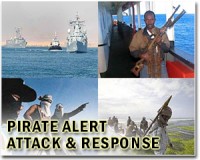| . |  |
. |
London (UPI) Sep 14, 2009 The Somali pirates preying on shipping in the Gulf of Aden and more recently the Indian Ocean are zeroed in on their targets by well-placed informers in London, a world center for shipbroking and insurance, using satellite phones, according to a European military intelligence report. The document, which was obtained by Cadena SER, a Spanish radio station, says the "consultants" in London help the pirates select their targets, providing data on the ships' cargoes and courses. An international armada of some 27 warships from 16 countries patrols the seas off Somalia, but the modern-day buccaneers are still able to strike. The attacks have eased off over the last few months because of the annual monsoon season. But that is coming to an end, and the shipping industry is bracing for a new surge of pirate attacks. The U.N. International Maritime Bureau reported this month that there had been a dramatic surge in piracy in the waters of the Horn of Africa -- 138 pirate attacks so far this year, with 33 vessels hijacked. Last year the pirates attacked more than 100 ships. The report was compiled by European military intelligence agencies and circulated to those countries involved in the European Union's naval Operation Atalanta to protect merchant vessels plying the maritime lanes off Somalia used by some 20,000 ships a year. In some cases, the report noted, the pirates had trained to attack specific ships well before the vessels reached the marauders' hunting grounds off Somalia. The ships are tracked en route to the Gulf of Aden and the Indian Ocean by the "consultants" operating in the close-knit ship brokerage and insurance markets in London. Once the vessels are in the pirates' operational zones, the marauders track them with Global Positioning Systems and radar and then pounce. The ships are held for ransom that, according to international security firms such as Control Risks in London or ASI Global in Houston, is usually delivered by airdrop in large floating plastic containers at pre-arranged spots at sea where the pirates pick it up when the coast is clear. Ransom payments are generally at least $2 million for a container ship or oil tanker. The money is then split up between the pirate crews, their controllers and the crooked shipping industry insiders in London, Dubai -- the financial hub of the Middle East -- and elsewhere who provide the intelligence, according to the private security companies that handle such cases. The crews of several hijacked merchant vessels have reported after they were released that the pirates knew everything about the layout of their ships, their cargoes and even the ports they had called at before they were overwhelmed. Andrew Mwangura of the East African Seafarers' Assistance Program in Mombasa, Kenya, who monitors the pirates' operations, noted that in many cases "the negotiations involve people in London." Ahmedou Ould-Abdallah, a U.N. special envoy to strife-torn Somalia, reported in July that Somalis living in the United Arab Emirates are suspected of aiding the pirates. "This is big money," he said. By conservative estimates, the pirate gangs were believed to have collected $30 million in ransom money in 2008, although some estimates go as high as $80 million. Share This Article With Planet Earth
Related Links 21st Century Pirates
 Anti-piracy equipment dazzles defence fair
Anti-piracy equipment dazzles defence fairLondon (AFP) Sept 8, 2009 Anti-piracy measures took centre stage at the world's largest defence fair Tuesday, with the unveiling of a laser to dazzle potential attackers before they can get too close. Amid stepped up international efforts to halt piracy, in particular in the Gulf of Aden, British defence firm BAE Systems unveiled a new non-lethal system for commercial vessels to help them spot and fend off attackers. ... read more |
|
| The content herein, unless otherwise known to be public domain, are Copyright 1995-2009 - SpaceDaily. AFP and UPI Wire Stories are copyright Agence France-Presse and United Press International. ESA Portal Reports are copyright European Space Agency. All NASA sourced material is public domain. Additional copyrights may apply in whole or part to other bona fide parties. Advertising does not imply endorsement,agreement or approval of any opinions, statements or information provided by SpaceDaily on any Web page published or hosted by SpaceDaily. Privacy Statement |